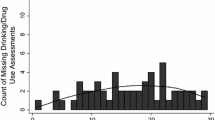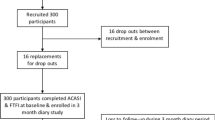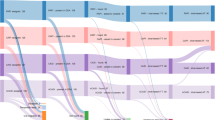Abstract
This study examined the accuracy of two retrospective methods and assessment intervals for recall of sexual behavior and assessed predictors of recall accuracy. Using a 2 [mode: audio-computer assisted self-interview (ACASI) vs. self-administered questionnaire (SAQ)] by 2 (frequency: monthly vs. quarterly) design, young women (N =102) were randomly assigned to one of four conditions. Participants completed baseline measures, monitored their behavior with a daily diary, and returned monthly (or quarterly) for assessments. A mixed pattern of accuracy between the four assessment methods was identified. Monthly assessments yielded more accurate recall for protected and unprotected vaginal sex but quarterly assessments yielded more accurate recall for unprotected oral sex. Mode differences were not strong, and hypothesized predictors of accuracy tended not to be associated with recall accuracy. Choice of assessment mode and frequency should be based upon the research question(s), population, resources, and context in which data collection will occur.

Similar content being viewed by others
Explore related subjects
Discover the latest articles and news from researchers in related subjects, suggested using machine learning.References
Aquilino, W. S., Wright, D. L., and Supple, A. J. (2000). Response effects due to bystander presence in CASI and paper-and-pencil surveys of drug use and alcohol use. Substance Use and Misuse, 35, 845–867.
Carey, M. P., Braaten, L. S., Maisto, S. A., Gleason, J. R., Forsyth, A. D., Durant, L. E., et al. (2000). Using information, motivational enhancement, and skills training to reduce the risk of HIV infection for low-income urban women: A second randomized clinical trial. Health Psychology, 19, 3–11.
Carey, M. P., Carey, K. B., Maisto, S. A., Gordon, C. M., and Weinhardt, L. S. (2001). Assessing sexual risk behavior with the timeline followback (TLFB) approach: Continued development and psychometric evaluation with psychiatric outpatients. International Journal of STDs and HIV, 12, 365–375.
Carey, M. P., Maisto, S. A., Kalichman, S. C., Forsyth, A. D., Wright, E. M., and Johnson, B. T. (1997). Enhancing motivation to reduce the risk of HIV infection for economically disadvantaged urban women. Journal of Consulting and Clinical Psychology, 65, 531–541.
Cheung, Y. B. (2002). Zero-inflated models for regression analysis of count data: A study of growth and development. Statistics in Medicine, 21, 1461–1469.
Cohen, J. (1988). Statistical power analysis for the behavioral sciences (2nd Ed.). Hillsdale, NJ: Erlbaum.
Des Jarlais, D. D., Paone, D., Milliken, J., Turner, C. F., Miller, H. G., Gribble, J. N., et al. (1999). Audio-computer interviewing to measure risk behaviors for HIV among injecting drug users: A quasi-randomized trial. Lancet, 353, 1657–1661.
Durant, L. E., and Carey, M. P. (2000). Self-administered questionnaires versus face-to-face interviews in assessing sexual behavior in young women. Archives of Sexual Behavior, 29, 309–322.
Durant, L. E., Carey, M. P., and Schroder, K. E. E. (2002). Effects of anonymity, gender, and erotophilia on the quality of data obtained from self-reports of socially sensitive behaviors. Journal of Behavioral Medicine, 25, 439–467.
Fehnel, S. E., Bann, C. M., Hogue, S. L., Kwong, W. J., and Mahajan, S. S. (2004). The development and psychometric evaluation of the motivation and energy inventory (MEI). Quality of Life Research, 13, 1321–1336.
Furukawa, T., Hirai, T., Kitamura, T., and Takahashi, K. (1997). Application of the center for epidemiologic studies depression scale among first-visit psychiatric patients: A new approach to improve its performance. Journal of Affective Disorders, 46, 1–13.
Graham, C. A., Catania, J. A., Brand, R., and Canchola, J. A. (2003). Recalling sexual behavior: A methodological analysis of memory recall bias via interview using the diary as a gold standard. Journal of Sex Research, 40, 325–332.
Hays, R., Hayashi, T., and Stewart, A. (1989). A five-item measure of socially desirable response set. Educational and Psychological Measurement, 49, 629–636.
Hewett, P. C., Mensch, B. S., and Erulkar, A. S. (2004). Consistency in the reporting of sexual behaviour by adolescent girls in Kenya: A comparison of interviewing methods. Sexually Transmitted Infections, 80(S2), ii43–ii48.
Horn, J., Nelson, C. E., and Brannick, M. T. (2004). Integrity, conscientiousness, and honesty. Psychological Reports, 95, 27–38.
Jaccard, J., McDonald, R., Wan, C. K., Dittus, P. J., and Quinlan, S. (2002). The accuracy of self-reports of condom use and sexual behavior. Journal of Applied Psychology, 32, 1863–1905.
Jaccard, J., and Wan, C. K. (1995). A paradigm for studying the accuracy of self-reports of risk behavior relevant to aids: Empirical perspectives on stability, recall bias, and transitory influences. Journal of Applied Social Psychology, 25, 1831–1858.
Kalichman, S. C., Rompa, D., and Coley, B. (1996). Experimental component analysis of a behavioral HIV-AIDS prevention intervention for inner-city women. Journal of Consulting and Clinical Psychology, 64, 687–693.
Kissinger, P., Rice, J., Farley, T., Trim, S., Jewitt, K., Margavio, V., et al. (1999). Application of computer-assisted interviews to sexual behavior research. American Journal of Epidemiology, 149, 950–954.
Kurth, A. E., Martin, D. P., Golden, M. R., Weill, N. S., Heagerty, P. J., Spielberg, F., et al. (2004). A comparison between audio computer-assisted self-interviews and clinician interviews for obtaining the sexual history. Sexually Transmitted Diseases, 31, 719–726.
Lambert, D. (1992). Zero-inflated Poisson regression, with an application to defects in manufacturing. Technometrics, 34, 1–14.
Locke, S. E., Kowaloff, H. B., Hoff, R. G., Safran, C., Popovsky, M. A., Cotton, D. J., et al. (1992). Computer-based interview for screening blood donors for risk of HIV transmission. JAMA, 268, 1301–1305.
Lubin, B., and Van Whitlock, R. (2002). Development of a measure that integrates positive and negative affect and personality: The comprehensive personality and affect scales. Journal of Clinical Psychology, 58, 1135–1156.
Newman, J. C., Des Jarlais, D. C., Turner, C. F., Gribble, J., Cooley, P., and Paone, D. (2002). The differential effects of face-to-face and computer interview modes. American Journal of Public Health, 92, 294–297.
Perlis, T. E., Des Jarlais, D. C., Friedman, S. R., Arasteh, K., and Turner, C. F. (2004). Audio-computerized self-interviewing versus face-to-face interviewing for research data collection at drug abuse treatment programs. Addiction, 99, 885–896.
Radloff, L. S. (1977). The CES-D scale: A self-report depression scale for research in the general population. Applied Psychological Measurement, 1, 385–401.
Reading, A. E. (1983). A comparison of the accuracy and reactivity of methods of monitoring male sexual behavior. Journal of Behavioral Assessment, 5, 11–23.
Roberts, R., Andrews, J., Lewinsohn, P., and Hops, H. (1990). Assessment of depression in adolescents using the center for epidemiologic studies depression scale. Psychological Assessment, 2, 122–128.
Romer, D., Hornik, R., Stanton, B., Black, M., Li, X., Ricardo, I., et al. (1997). “Talking” computers: A reliable and private method to conduct interviews on sensitive topics with children. Journal of Sex Research, 34, 3–9.
Schroder, K. E. E., Carey, M. P., and Vanable, P. A. (2003). Methodological challenges in research on sexual risk behavior: Ii. Accuracy of self-reports. Annals of Behavioral Medicine, 26, 104–123.
Turner, C. F., Ku, L., Rogers, S. M., Lindberg, L. D., Pleck, J. H., and Sonenstein, F. L. (1998). Adolescent sexual behavior, drug use, and violence: Increased reporting with computer survey technology. Science, 280, 867–873.
Turner, C. F., Ku, L., Sonenstein, F. L., and Pleck, J. H. (1996). Impact of ACASI on reporting of male–male sexual contacts: Preliminary results from the 1995 national survey of adolescent males. In R. B. Warnecke (Ed.), Health survey research methods: Conference proceedings (pp. 996–1013). Hyattsville, MD: National Center for Health Statistics.
Webb, P. M., Zimet, G. D., Fortenberry, J. D., and Blythe, M. J. (1999). Comparability of a computer-assisted versus written method for collecting health behavior information from adolescent patients. Journal of Adolescent Health, 24, 383–388.
Weinhardt, L. S., Forsyth, A. D., Carey, M. P., Jaworski, B. C., & Durant, L. E. (1998). Reliability and validity of self-report measures of HIV-related sexual behavior: Progress since 1990 and recommendations for research and practice. Archives of Sexual Behavior, 27, 155–180.
Acknowledgments
This research was funded by the National Institutes of Health (R01 NR008194 to DMB) as well as the National Institute of Mental Health (K02 MH01582 to MPC). The authors would like to thank the participants of the study for their important contribution to HIV-prevention science.
Author information
Authors and Affiliations
Corresponding author
Rights and permissions
About this article
Cite this article
Morrison-Beedy, D., Carey, M.P. & Tu, X. Accuracy of Audio Computer-Assisted Self-Interviewing (ACASI) and Self-Administered Questionnaires for the Assessment of Sexual Behavior. AIDS Behav 10, 541–552 (2006). https://doi.org/10.1007/s10461-006-9081-y
Published:
Issue Date:
DOI: https://doi.org/10.1007/s10461-006-9081-y




